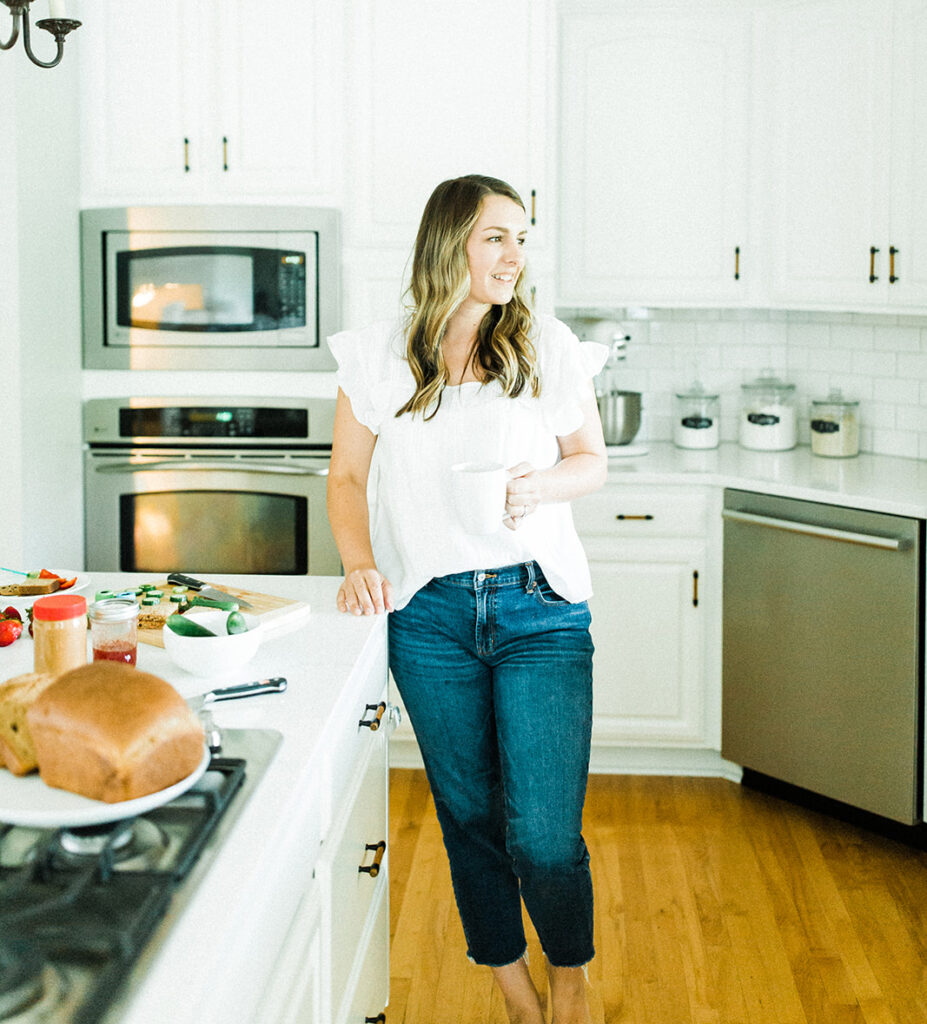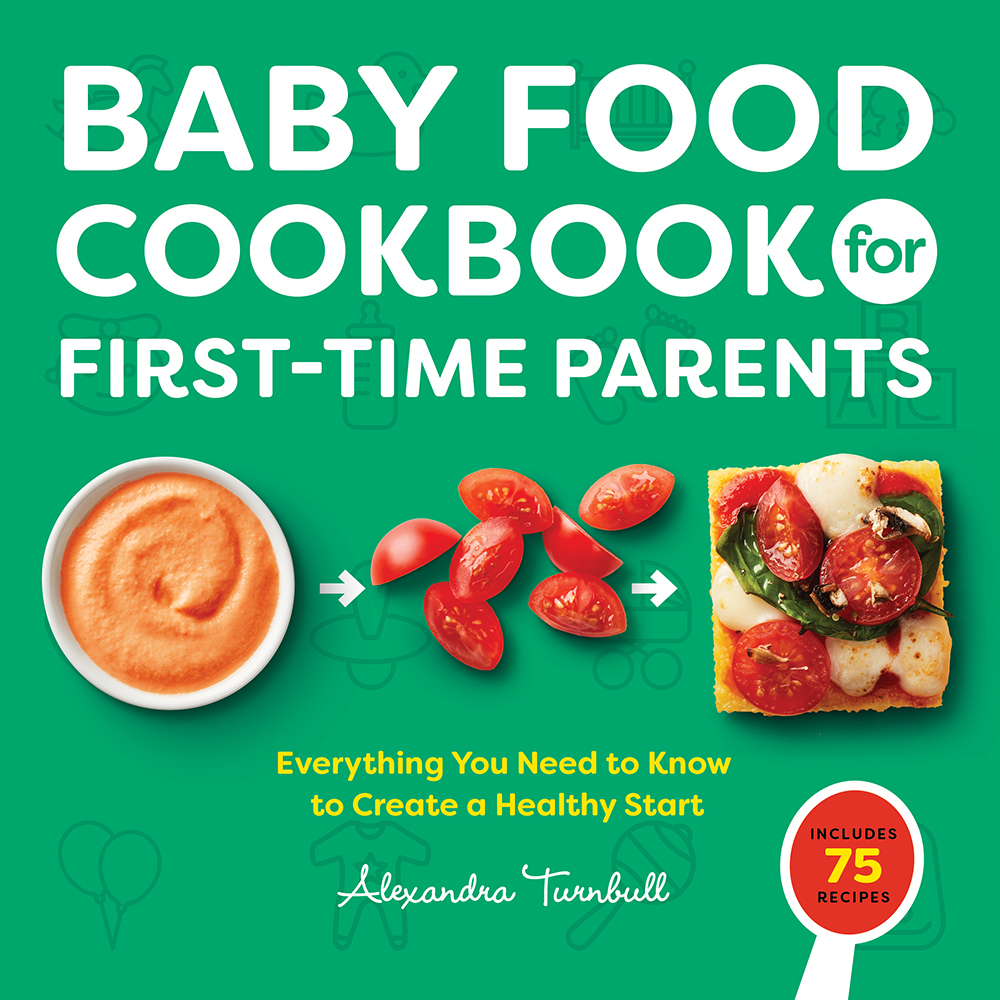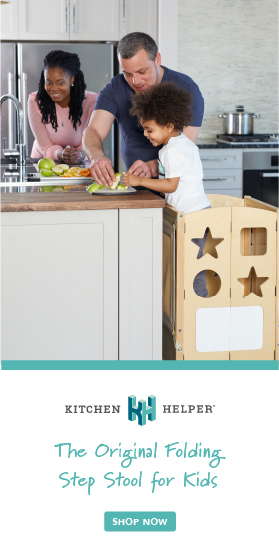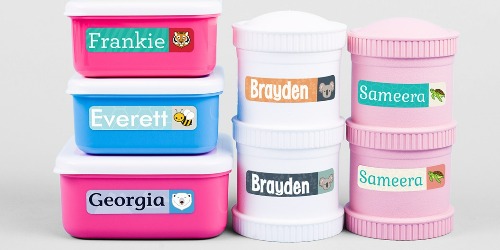Table of Contents
What is Baby Led Weaning?
This post is sponsored by Stonyfield Organic. All opinions are my own.
Baby led weaning (BLW) is a feeding approach that promotes self-feeding rather than the traditional spoon-fed approach. Essentially your baby is the one feeding themselves, no matter it a puree or soft table food, rather than the parent feeding the baby.
The term BLW was first coined by Gill Rapley in 2005 and has quickly gained popularity within the parenting community.
You might be wondering how it’s possible for a baby to eat soft table foods without teeth or feed themselves in general, but it’s possible if done correctly.
Throughout this post, we will discuss what baby led weaning is, the benefits of BLW, how to prepare foods safely for BLW, and the 10 best first foods for BLW.
If you find yourself nervous or stressed about baby led weaning or introducing solids and aren’t sure which foods would be the best to start with, you’re in the right place. You’ll finish reading this blog post with the knowledge and confidence you need to safely feed your baby.
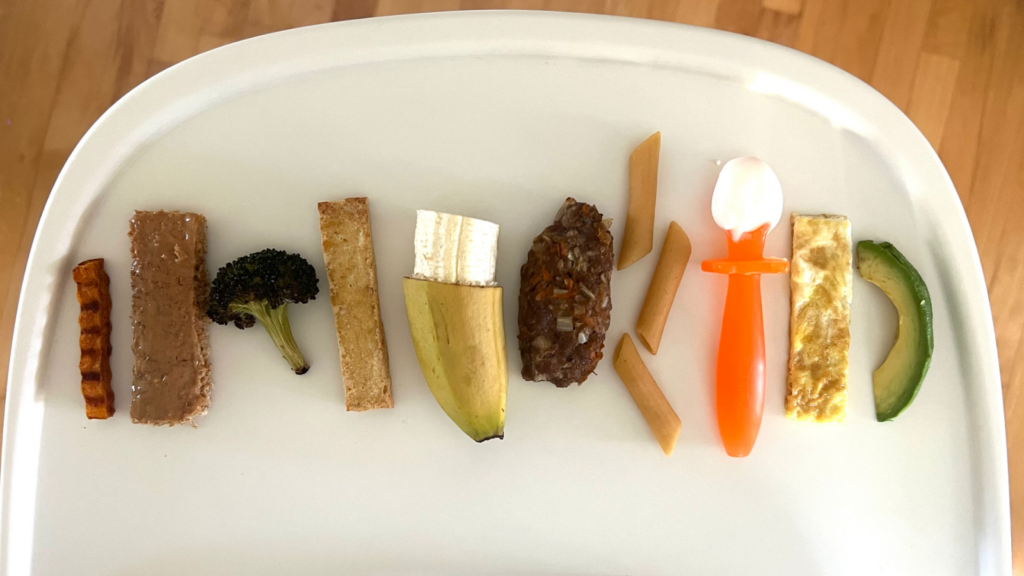
When is my baby ready to begin solids?
Many parents hit the 6-month mark and automatically think their baby is ready to begin solids. More important than how old your baby is, is whether or not they are developmentally ready and every baby is different.
Look for these signs of readiness prior to introducing solids to ensure your baby is developmentally ready.
- Around 6 months of age
- Good head control
- Able to sit up with minimal assistance
- Bringing objects to mouth
- Interested in food
Once your baby is consistently showing these signs, it’s safe to introduce solids. Always speak to your baby’s pediatrician regarding developmental or health concerns.
Benefits of Baby Led Weaning
Many parents think they have to pick a side when it comes to which feeding approach they choose; the traditional spoon-fed or baby led weaning approach, but you don’t have to!
The truth is, the best approach is the one you choose for your baby and you can absolutely do a combination if you’d like.
The feeding approach you choose may depend on where you are and what you are doing. Sometimes it’s easier to control the situation and spoon-feed purees. Other times it’s actually simpler to feed them the soft table foods you’re eating. Choose flexibility, not rigidity when it comes to feeding your baby.
While there’s no one right way to feed your baby, BLW does have several benefits.
- Baby eats many of the same foods you do making it easier to prepare meals.
- No need to purchase store-bought baby food, or at least less if doing a combination.
- May be more open to a wider variety of foods, minimizing picky eating in the future.
- Babies fed with the BLW approach were linked to having better satiety-responsiveness.
- Lower chance of childhood obesity.
How to cut food for baby led weaning
Even though you can offer your baby many of the same foods you eat with a BLW approach, you still need to make sure the foods you provide are developmentally appropriate.
When preparing foods for your baby, they should be soft, easy to mash with zero to few teeth, and easy to pick up and hold on to.
When cutting food for your baby, aim for pieces that are long – think the size of 1-2 adult fingers. This makes it easier for your baby to pick food up using their whole hand (palmar grasp). Once they start to pick up pieces of food with their index finger and thumb (pincer grasp), you can begin to cut foods into small, pea-sized pieces.
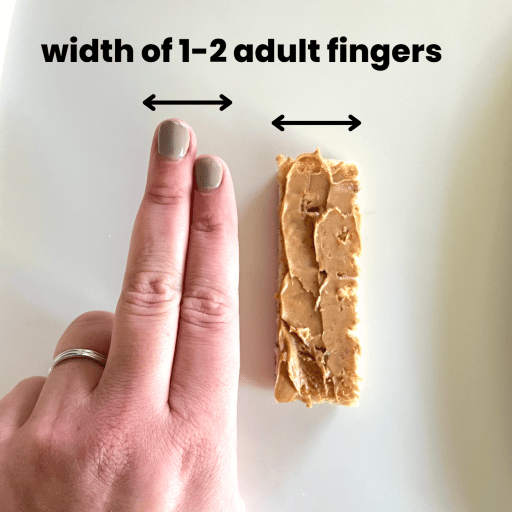
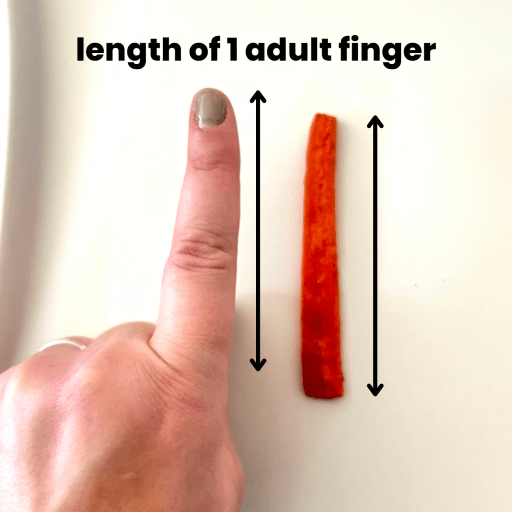
Foods you should avoid feeding your baby
- Hard, round, and sticky foods can increase the risk of choking.
- Honey before 12 months due to the potential for infant botulism
- Cows milk as a beverage before 12 months. Yogurt, cheese, and other dairy products are safe to offer your baby starting at 6 months of age..
- Minimize foods with sodium or added sugar if and when possible.
All adults or caregivers, including yourself, that are involved with feeding your baby should take a CPR course so they know what to do in case your baby chokes. I also recommend the Thrive Training Institute’s Choking Prevention and Response Course. Use code ALEX10 for $10 off.
How to build a balanced plate for your baby
When building a balanced meal for your baby, it’s important to prioritize certain foods to maximize the nutritional value in every bite and spoonful they take.
Whether you choose the traditional spoon-fed approach or baby led weaning, breast milk or formula will still be their main source of nutrition through their first year of life. Prioritize adding in solids, but know that you don’t have to do it all at once.
When choosing foods to feed your baby, you should include foods that fit into these categories: iron foods, high-energy foods, fruits, and vegetables, as well as common allergens. Providing foods from these categories will help your baby consume a wider variety of nutrients.
Iron Foods
At 6 months of age, your baby will start to lose the iron stores that they were born with. Iron helps transport oxygen throughout the body, to the brain, making it a very important mineral for your baby.
Read more about iron-rich foods here.
Sources: animal meats, nuts, beans, seeds, tofu, eggs, dark green vegetables, enriched grains.
High-Energy Foods
The first 1,000 days of your baby’s life are critical for brain development and growth. High-fat foods have been associated with improved cognition and attention. Choose a full-fat yogurt like Stonyfield YoBaby cups and pouches made with whole milk.
Sources: avocado, whole milk yogurt, cheese, nut and tree nut butters, butter, eggs
Fruits and Vegetables
Both fruits and vegetables should be introduced to your baby from the get-go. They provide a wide variety of nutritional benefits including vitamins, minerals, fiber, and antioxidants.
Sources: banana, applesauce, avocado, sweet potato, peas, broccoli, etc
Common Allergens
Contradictory to what many of us grew up with, research now states that introducing common allergens, such as peanuts, early and often can help prevent food allergies. Prioritize introducing common allergens into your baby’s diet along with a wide variety of other foods.
Top 9 Allergens: peanuts, tree nuts, egg, soy, milk, wheat, fish, shellfish, sesame.
How to offer common allergens:
Peanuts – mix nut butter into any fruit or vegetable puree and preload onto a spoon
Tree nuts – mix ground tree nuts into any fruit or vegetable puree and preload onto a spoon
Egg – omelet strips, scrambled, baked into foods like french toast, pancakes, etc
Soy – tofu strips
Milk – Stonyfield YoBaby yogurt cups preloaded on a spoon
Wheat – pasta, cereal, a strip of toast
Fish – grilled, broiled, pan-fried, or baked salmon, tilapia, etc
Shellfish – crab meat, ground shrimp
Sesame – sesame seeds sprinkled on foods, sesame oil
Best first foods for blw
Now that you know what BLW is and how to build a balanced plate for your baby, let’s talk about what to offer.
As a dietitian and expert in feeding infants and children, I’ve laid out the 10 best first foods for BLW to help you get started. If you’ve already started you can easily add these to the rotation.
I chose these 10 best first foods for blw for you to prioritize when introducing solids to your baby because they fit into one or more of the following categories:
- Iron foods
- High-energy foods
- Fruit or vegetable
- Common allergen
- Safe texture
Avocado
Avocado is technically a fruit. A unique fruit in that it is high-fat and most fruits contain very little fat. Due to its high-fat content, it’s a great high-energy option for your baby that also the perfect texture.
How to offer: mashed and preloaded on a spoon, spread on a 2” strip of toast, as a wedge rolled in ground flax, chia seeds, or infant cereal for an easy grip.
Egg
Eggs for baby led weaning is a great option. Not only are they a common allergen that should be introduced early and often to your baby, but eggs contain iron and choline, which is good for brain development.
How to offer: scrambled, omelet strip, hard-boiled wedge, baked into foods like french toast.
Yogurt
Some people think that you can’t offer yogurt with a BLW approach due to its puree consistency, but sure you can! While more often than not, blw does include soft, whole table foods, purees also have an extremely valuable place in a baby’s diet, no matter the approach.
To offer yogurt blw style, simply dip an easy-to-hold baby utensil in yogurt and place the utensil in front of your baby. This not only allows your baby to practice using a utensil, they still get the many nutritional benefits of yogurt.
I recommend Stonyfield YoBaby Yogurt cups as the best yogurt for babies. They’re made with organic whole milk and contain protein, calcium, Vitamin D, probiotics, plus live and active cultures. They’re also #1 pediatrician recommended for babies 6 months to 2 years among refrigerated yogurts.
(IQVIA ProVoice Survey, 12/01/15-08/31/21).
How to offer: preloaded on a spoon and spread on toast or teething biscuit.
There are many more ways to offer yogurt to your baby, check them out here!
Pasta
Grain products like pasta, cereal, and bread are fortified with iron, making them a great option to introduce to your baby. I recommend a lentil or chickpea-based pasta for even more iron, fiber, and other vitamins and minerals than regular pasta.
How to offer: rotini or another long noodle that is cooked well and easy to hold onto.
Beef
Beef contains .47 mg of heme iron per 1 oz. Heme iron is found in animal products and is the more absorbable form of iron compared to non-heme iron found in plant sources. Learn more about the amounts of iron in different foods here.
How to offer: pureed and pre-loaded on a spoon, as a meatball or mini meatloaf – recipes found in my Baby Food Cookbook.
Banana
Bananas are a common first food for babies due to their mashable texture and natural sweetness. Nutritionally they contain fiber, which will help keep them regular as you start to introduce solids and their poops change.
How to offer: pureed and pre-loaded on a spoon, long strip rolled in chia, ground flax, or infant cereal, or whole with part of the peel left on for an easy grip.
Tofu
Tofu is essentially pressed soybeans and comes in the form of dense white blocks you can typically find in your produce or refrigerated sections. Because soy is a common allergen, contains iron, and is an easy texture for your baby to manage, it’s a great first food option for your baby.
How to offer: cut tofu into strips roughly ½” thick and 2” long. Fry in a cast iron skillet to help increase iron absorption. Lightly brown each side, cool, and place in front of your baby at meal time to practice picking up themselves.
Broccoli
Vegetables are often given a bad reputation for being “yucky” right off the bat, but we can change that so they learn to enjoy veggies instead of despising them.
What’s unique about broccoli is that it not only contains iron but also Vitamin C. Vitamin C actually helps your body better absorb iron, an important mineral for your baby.
How to offer: pureed, roasted with oil, or cooked broccoli tops sprinkled into foods.
Nut Butter
New research now recommends introducing nut butter, such as peanut butter, around 6 months to minimize the chance of food allergies Not only is it a common food allergen, but nut butter also contains iron, protein, and healthy fats.
How to offer: mix any nut butter into a puree, add to smoothies, and spread on a strip of toast.
Sweet Potato
Sweet potatoes are easy to offer both pureed or as a table food and contain fiber, vitamins, and minerals which help support your baby’s immune system and gut health.
How to offer: mixed into a puree, mashed and preloaded on a spoon, or 2” strips roasted.
Where do you begin?
There are many more great soft table food options you can offer your baby or toddler. Start by picking one food and simply build onto the list of offered foods from there.
10 best first foods for blw:
- Avocado
- Egg
- Yogurt
- Pasta
- Beef
- Banana
- Tofu
- Broccoli
- Nut butter
- Sweet Potato
And remember, you don’t have to pick a side, you can offer your baby a combination of both BLW and traditional spoon feeding. Choose what works best for you.
Here are a few of my favorite products to help you get started:
Best high chair for BLW: Abiie Beyond Junior
Best Bibs for BLW: silicone bibs with catcher
Best utensils for BLW: Grabease, Eztotz silicone baby spoon, Sperric silicone baby spoon, Ezpz utensils.
Grab my Baby Food Cookbook and enjoy 75 simple recipes, many that the whole family can enjoy!

